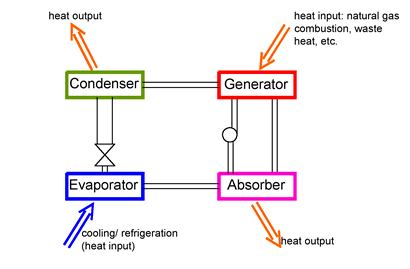- Home
- About Us
- Absorption Process
- Applications
- Publications, Technical Papers, News Releases
- Patent Estate
- Case Studies
- Energy Links
- Contact Us
(410) 266-6521
Get Our News
Sign up below to subscribe to our news
The Absorption Process
The Absorption Cycle was invented in 1846 by Ferdinand Carré for the purpose of producing ice with heat input. It is based on the principle that absorbing ammonia in water causes the vapor pressure to decrease. Absorption cycles produce cooling and/or heating with thermal input and minimal electric input, by using heat and mass exchangers, pumps and valves.
 An absorption cycle can be viewed as a mechanical vapor-compression cycle, with the compressor replaced by a generator, absorber and liquid pump. The absorption cycle enjoys the benefits of requiring a fraction of the electrical input, plus uses the natural substances ammonia and water, instead of ozone depleting halocarbons. The absorption cycle enjoyed widespread use from the 1920’s as gas powered refrigerators/ice-makers.
An absorption cycle can be viewed as a mechanical vapor-compression cycle, with the compressor replaced by a generator, absorber and liquid pump. The absorption cycle enjoys the benefits of requiring a fraction of the electrical input, plus uses the natural substances ammonia and water, instead of ozone depleting halocarbons. The absorption cycle enjoyed widespread use from the 1920’s as gas powered refrigerators/ice-makers.
The basic operation of an ammonia-water absorption cycle is as follows. Heat is applied to the generator, which contains a solution of ammonia water, rich in ammonia. The heat causes high pressure ammonia vapor to desorb the solution.
Heat can either be from combustion of a fuel such as clean-burning natural gas, or waste heat from engine exhaust, other industrial processes, solar heat, or any other heat source. The high pressure ammonia vapor flows to a condenser, typically cooled by outdoor air. The ammonia vapor condenses into a high pressure liquid, releasing heat which can be used for product heat, such as space heating.
The high pressure ammonia liquid goes through a restriction, to the low pressure side of the cycle. This liquid, at low pressures, boils or evaporates in the evaporator. This provides the cooling or refrigeration product. The low pressure vapor flows to the absorber, which contains a water-rich solution obtained from the generator.
This solution absorbs the ammonia while releasing the heat of absorption. This heat can be used as product heat, or for internal heat recovery in other parts of the cycle, thus unloading the burner and increasing cycle efficiency. The solution in the absorber, now once again rich in ammonia, is pumped to the generator, where it is ready to repeat the cycle.
An absorption cycle can use a variety of working pairs. The working pair is made up of a refrigerant, typically ammonia or water; and a solution which absorbs the refrigerant. Other working pairs include lithium-bromide-water; TriDroxide-water; and Alkitrate-water. Tridroxide and Alkitrate are Energy Concepts patented working pairs with specialty applications in industry.
Absorption cycles can operate at high efficiency by utilizing advanced cycles, using generator-absorber heat exchange, multiple pressures, and multiple effects. These cycles use extensive internal heat recovery to require less prime fuel input to produce the same thermal output. High efficiency operation, plus benefits of environmentally friendly refrigerants, clean-burning fuels, and few moving parts requiring maintenance make absorption a very good choice for consumers.
Absorption cycles can produce a variety of thermal outputs. In common commercial use today are gas-fired absorption chillers, which produce chilled water for space cooling applications. The absorption cycle can produce low temperature cooling for ice production or cold storage.
Turbine inlet cooling is a very efficient use of absorption cooling, boosting turbine efficiency by up to 15%. Many other applications exist in industry, where waste heat is available and cooling is required. Advanced cycles can also produce electrical or shaft power by producing steam or high pressure vapor to power a turbine/generator pair.
© Copyright 2000 - 2016 Energy Concepts Co. LLC. All Rights Reserved.
Website Design © Copyright 2013-2016 by Workable Web Solutions, LLC. All Rights Reserved.
